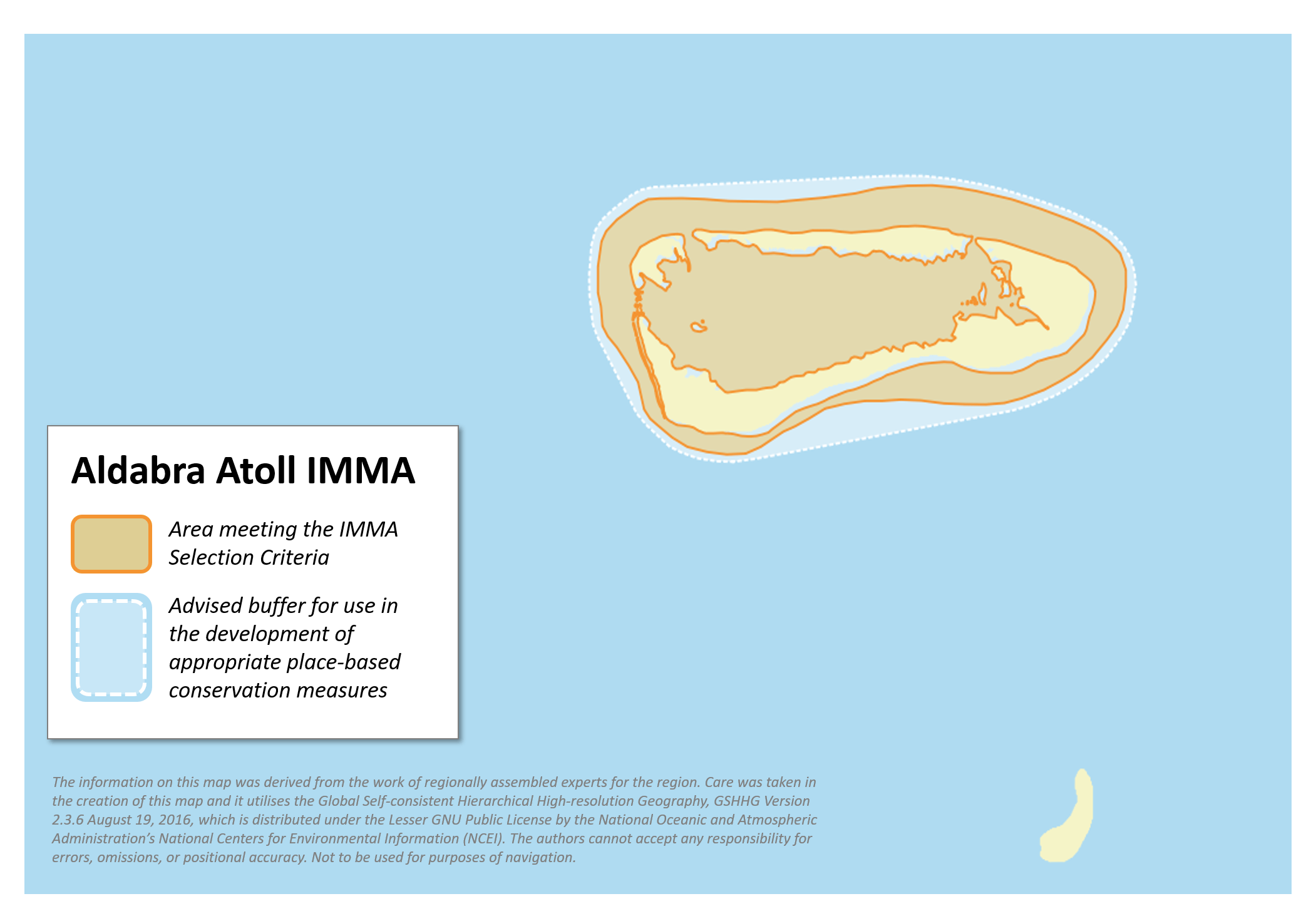Aldabra Atoll IMMA
Size in Square Kilometres
158 283 km2
Qualifying Species and Criteria
Dugong – Dugong dugon
Criterion A; C (i, ii)
Humpback whale – Megaptera novaeangliae
Criterion C (i, iii)
Marine Mammal Diversity
Delphinus delphis, Dugong dugon, Globicephala macrorhynchus, Grampus griseus, Megaptera novaeangliae, Mesoplodon densirostris, Orcinus orca, Peponocephala electra, Physeter macrocephalus, Pseudorca crassidens, Stenella attenuata, Stenella longirostris, Tursiops truncatus, Ziphius cavirostris
Download fact sheet
Summary
The Aldabra Atoll is a large coral atoll located over 1000 km southwest of the main island of Mahé. Designated as a marine UNESCO World Heritage Site in 1982, the atoll and its associated lagoons, slopes, reefs and deep surrounding waters have been strictly protected ever since. The extensive seagrass beds of the inner lagoon and seaward reef flat provide important feeding and breeding habitat for the only known remaining population of dugongs (Dugong dugon) in the Seychelles island group. From July to November, the atoll’s lagoons and outer waters also serve as calving, nursing and mating areas for humpback whales (Megaptera novaeangliae) that migrate from Southern Hemisphere feeding areas.
Description of Qualifying Criteria
Criterion A – Species or Population Vulnerability
Aldabra is now the only location in Seychelles where dugongs occur (Hermans and Pistorius, 2008). Classified as Vulnerable on the IUCN Red List, dugongs in east Africa are thought to be more highly threatened (Marsh et al. 1992). Aldabra hosts vast areas of seagrass beds both inside the lagoon (Hamylton et al. 2012) and on the seaward reef flat (Haupt et al. 2015). Spatial analysis of dugong sightings suggests a co-occurrence of dugongs and seagrass beds inside the lagoon (Hamylton et al. 2012). Aldabra therefore contains habitat important for the survival for the dugong and meets Criterion A. Furthermore, Aldabra’s dugongs include breeding females and calves, indicating the site may be a key area for the population and a promising area for population recovery (Appoo et al. 2019).
Criterion C: Key Life Cycle Activities
Sub-criterion Ci: Reproductive Areas
A partial aerial survey of the lagoon in 2013 recorded a minimum of 14 dugongs in the area covered, which is by far the largest number counted to date and suggests that the total population in the lagoon is between 20-25 individuals. The survey also recorded calves, indicating that Aldabra is a breeding or nursery site for the species (Appoo et al. 2019). Humpback whales with calves are observed around Aldabra from July to November (Hermans and Pistorius, 2008; Appoo et al. 2019), coinciding with the breeding period of humpback whales in the region (e.g., Rosenbaum et al. 2009; Fossette et al. 2014). The atoll therefore forms part of the broader humpback whale breeding area known in the region.
Sub-criterion Cii: Feeding Areas
Aldabra’s hosts extensive seagrass beds found inside the lagoon as well as on the outer reef flat. The seagrass beds are considered to be near-pristine due to little anthropogenic impacts and strict protection of the atoll. Aldabra’s large, shallow lagoon and extensive seagrass beds therefore provide ideal foraging habitat for dugongs, which are seagrass specialists. Previous research has indicated a cluster of dugong sightings in the lagoon correlated with seagrass areas (Hamylton et al. 2012). This suggests that the lagoon represents important foraging habitat for this species.
Sub-criterion Ciii: Migration Routes
Aldabra is on the migration route of humpback whales associated with Breeding Stock C as they move annually between feeding areas in the Southern Ocean and breeding (wintering) areas off east Africa, the islands of the Mozambique Channel, Madagascar, and the Mascarenes (e.g., Fossette et al. 2014; Cerchio et al. 2016). Humpback whales make up the highest proportion of marine mammal sightings on Aldabra (Hermans & Pistorius, 2008; Appoo et al. 2019). Humpback whales on Aldabra are seen exclusively between July and November, with calves, indicating that the atoll represents part of the breeding/nursery area for this population of humpback whales (Appoo et al. 2019)
Supporting Information
Appoo, J., Sanchez, C., Burt, A.J, Richards, H., Van de Crommenacker, J., Currie, J. and Fleischer-Dogley, F. In Press. ‘The use of Aldabra and its protected waters by marine mammals’. Seychelles Research Journal.
Cerchio, S., Trudelle, L., Zerbini, A.N., Charrassin, J.B., Geyer, Y., Mayer, F.X., Andrianarivelo, N., Jung, J.L., Adam, O. and Rosenbaum, H.C. 2016. ‘Satellite telemetry of humpback whales off Madagascar reveals insights on breeding behavior and long-range movements within the southwest Indian Ocean’. Marine Ecology Progress Series, 562: 193–209.
Fosette, S., Heide-Jorgensen, M.P., Jensen, M.V., Kiszka, J., Bérube, M., Bertrand, N. and Vély, M. 2014. ‘Humpback whale (Megaptera novaeangliae) post breeding dispersal and southward migration in the western Indian Ocean’. Journal of Experimental Marine Biology and Ecology, 450: 6–14.
Hamylton, S., Hagan, A. and Doak, N. 2012. ‘Observations of dugongs at Aldabra Atoll, western Indian Ocean: lagoon habitat mapping and spatial analysis of sighting records’. International Journal of Geographical Information Science, 26: 839–853.
Haupt, P.W., Klaus, R. and Turner, J.R. 2015. ‘Mapping the Aldabra seaward habitat 2012-2015’. Seychelles Island Foundation Scientific Report: pp 116. Unpublished report for the GEF Project ID 3925: Strengthening Seychelles’ protected area system through NGO management modalities. Outcome 2.3: The offshore boundary of the Aldabra Special Reserve is expanded, and its management strengthened.
Hermans, A. and Pistorius, P.A. 2008. ‘Marine Mammal Diversity in the Remote Waters of Aldabra Atoll, Southern Seychelles’. Atoll Research Bulletin, 564: 1–9.
Marsh, H., Penrose, H., Eros, C. and Hugues, J. 1992. Dugong Status Report and Action Plans for Countries and Territories. Early Warning and Assessment Reports Series. UNEP/IUCN. pp. 19–35.
Plön, S., Thakur, V., Parr, L. and Lavery, S. In press. ‘The phylogeography of the dugong (Dugong dugon) based on historical samples identifies vulnerable populations’. PLoS One.
Rosenbaum, H.C., Pomilla C., Mendez, M., Leslie M.S., Best, P.B., Findlay, K.P., Minton, G. et al. ‘Population structure of humpback whales from their breeding grounds in the South Atlantic and Indian Oceans’. PLoS One 4 (10): e7318. Available at: doi.org/10.1371/journal.pone.0007318. (Accessed: 1 February 2019).
SIF. 2016. ‘Aldabra Atoll Management Plan’. Seychelles Islands Foundation (SIF), 1–98. Available at: https://www.sif.sc/sites/default/files/downloads/Aldabra%20Atoll%20Management%20Plan.pdf. (Accessed: 1 February 2019).


